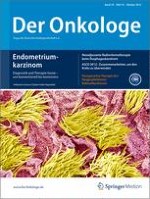Erschienen in:

01.10.2012 | Leitthema
Neues zur Epidemiologie und Ätiologie des Endometriumkarzinoms
verfasst von:
Prof. Dr. Dr. D. Schmidt, L. Kiesel
Erschienen in:
Die Onkologie
|
Ausgabe 10/2012
Einloggen, um Zugang zu erhalten
Zusammenfassung
Die endometrialen Adenokarzinome können in 2 Gruppen unterschieden werden: Typ-1-Karzinome sind oft hoch differenziert, klinisch wenig aggressiv, östrogenassoziiert und antiöstrogen behandelbar. Auf molekularer Ebene finden sich Veränderungen von PTEN, KRAS und β-Catenin. Außerdem ist in einem Teil der Fälle eine Mikrosatelliteninstabität (MSI) nachweisbar. Typ-2-Karzinome sind demgegenüber prognostisch zumeist ungünstige, nicht östrogenassoziierte Tumoren mit Tendenz zu früher Metastasierung und molekularen Veränderungen, die die Gene p53 und p16 betreffen. Vorläuferläsion des endometrioiden Karzinoms ist die atypische Hyperplasie, diejenige des serösen und klarzelligen Adenokarzinoms höchstwahrscheinlich eine endometriale glanduläre Dysplasie. Während Östrogene auf das Endometrium eine stimulierende Wirkung haben, wirken Gestagene antiproliferativ. Die Wirkung von Tamoxifen ist variabel und hängt wahrscheinlich stark davon ab, in welchem Zustand sich das Endometrium vor Beginn der Behandlung befunden hat. Tamoxifen ist ein Risikofaktor für die Entstehung von uterinen Tumoren unterschiedlicher Histogenese. Es treten sowohl Tumoren auf, die normalerweise in einen Zusammenhang mit Östrogenen gebracht werden, als auch solche, die nicht mit einer östrogenen Assoziation gesehen werden. Weitere wichtige Risikofaktoren für die Entstehung eines Endometriumkarzinoms sind eine Langzeiteinnahme von Östrogenen ohne Gestagenschutz, eine Hormontherapie mit einer kürzer als 12 Tage/Monat dauernden Gestagengabe, ein metabolisches Syndrom mit Adipositas, ein Diabetes mellitus, eine fettreiche Ernährung, ein PCO-Syndrom, Nulliparität, eine frühe Menarche und späte Menopause. Ein signifikant erhöhtes Risiko besteht auch bei Frauen mit einem autosomal-dominanten HNPCC-Syndrom.